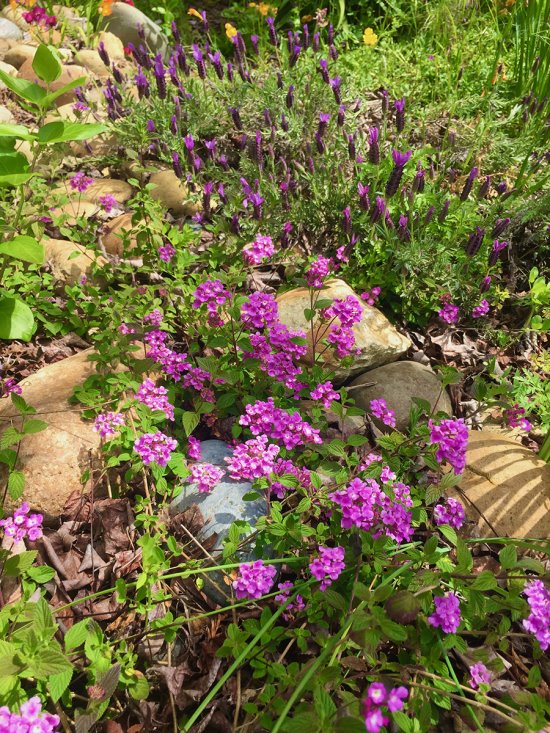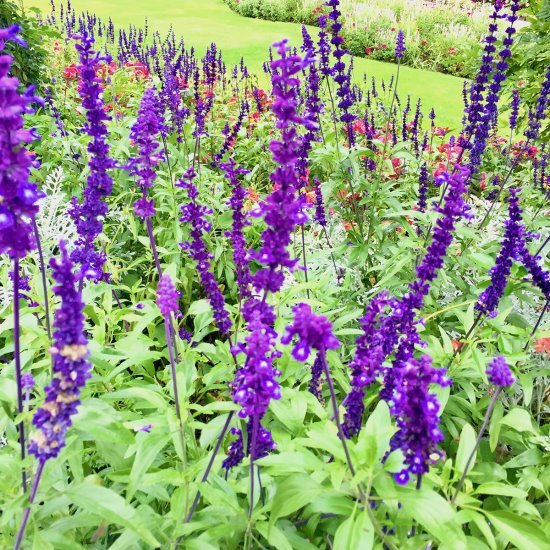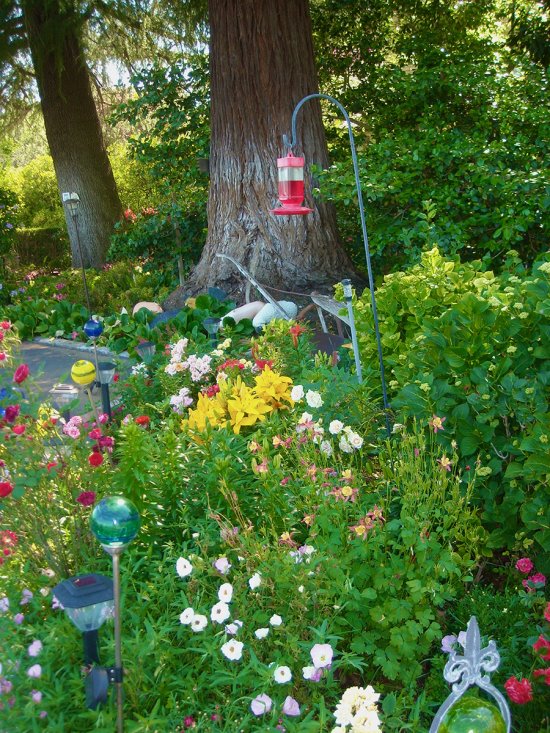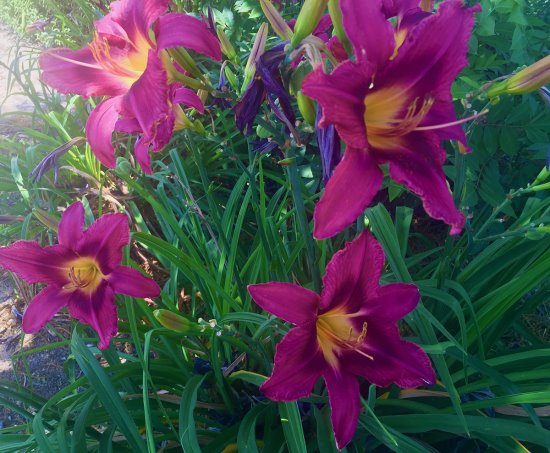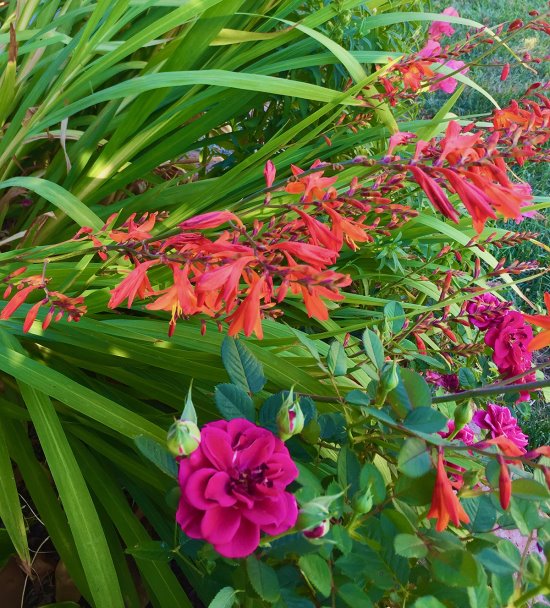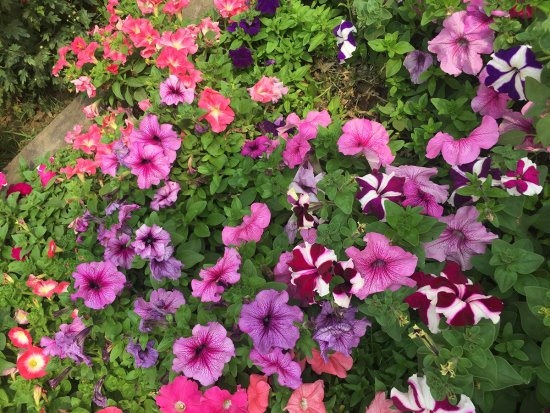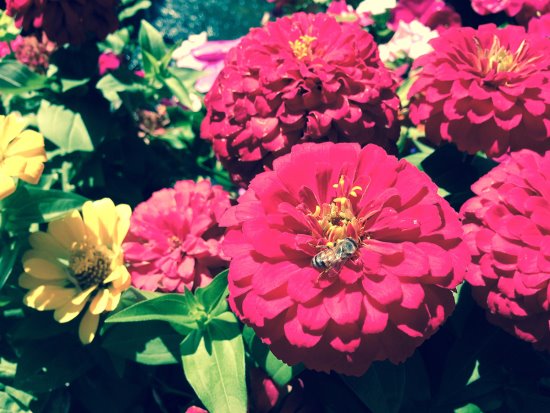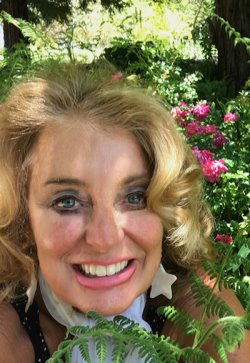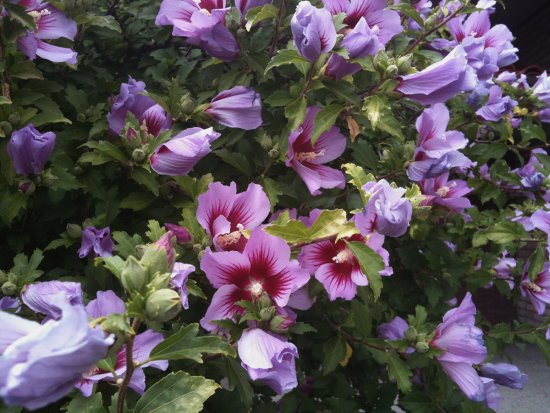 |
|
|
You might get up close and personal when you add a Rose of Sharon hibiscus to your hair. Photos Cynthia Brian
|
|
|
|
|
|
By Cynthia Brian

 "Like the hummingbird sipping nectar from every flower, I fly joyfully through my days, seeing beauty in everything."- Amethyst Wyldfyre
"Like the hummingbird sipping nectar from every flower, I fly joyfully through my days, seeing beauty in everything."- Amethyst Wyldfyre

 After tucking a hibiscus plucked from my mother's garden behind my ear, I was immediately the object of desire for a hungry hummer. The iridescent red crown identified the hovering nectar hunter as a male Anna's hummingbird. The females and young have green crowns. What a photo op, but alas, no camera or iPhone in sight.
After tucking a hibiscus plucked from my mother's garden behind my ear, I was immediately the object of desire for a hungry hummer. The iridescent red crown identified the hovering nectar hunter as a male Anna's hummingbird. The females and young have green crowns. What a photo op, but alas, no camera or iPhone in sight.
 Of the known 331 species of hummingbirds, 27 types are found in the United States, and 14 reside in California. Hummers only live in North and South America. When most people think of pollinators, bees, butterflies, bats, beetles, birds, and moths may come to mind. Yet, hummingbirds are some of the greatest pollinators as they can visit one to three thousand flowers in a single day. As they whiz from flower to flower, pollen from the stamen sticks to their long bills and forehead as they feed. They prefer plants with tubular-shaped flowers and many plants have evolved (some with the help of human intervention) to be more attractive to hummingbirds with brighter colors, higher nectar counts, and daylight blooms. Because they have long, slim bills, hummingbirds can feed deep into chambers and cannulas that bees or other pollinators cannot reach. They also eat tiny insects and spiders that are detrimental to flower beds and vegetable gardens.
Of the known 331 species of hummingbirds, 27 types are found in the United States, and 14 reside in California. Hummers only live in North and South America. When most people think of pollinators, bees, butterflies, bats, beetles, birds, and moths may come to mind. Yet, hummingbirds are some of the greatest pollinators as they can visit one to three thousand flowers in a single day. As they whiz from flower to flower, pollen from the stamen sticks to their long bills and forehead as they feed. They prefer plants with tubular-shaped flowers and many plants have evolved (some with the help of human intervention) to be more attractive to hummingbirds with brighter colors, higher nectar counts, and daylight blooms. Because they have long, slim bills, hummingbirds can feed deep into chambers and cannulas that bees or other pollinators cannot reach. They also eat tiny insects and spiders that are detrimental to flower beds and vegetable gardens.
 Native and navitar plants that are red, blue, orange, yellow, blue and purple are favorites. What is the difference between native and navitar plants?
Native and navitar plants that are red, blue, orange, yellow, blue and purple are favorites. What is the difference between native and navitar plants?
 Native:
Native:
 highly adapted to the climate and soil they are naturally growing in
highly adapted to the climate and soil they are naturally growing in
 requires less babying (within their particular climate) than non-natives
requires less babying (within their particular climate) than non-natives
 promotes biodiversity throughout your garden
promotes biodiversity throughout your garden
 naturally resistant to local pests
naturally resistant to local pests
 attract beneficial pollinators
attract beneficial pollinators
 Navitar:
Navitar:
 combination of the words `native' and `cultivar' (result of careful selection and crossbreeding by humans)
combination of the words `native' and `cultivar' (result of careful selection and crossbreeding by humans)
 wider variety of flower colors, shapes and forms
wider variety of flower colors, shapes and forms
 incorporate different sizes of plant
incorporate different sizes of plant
 heightened insect or disease resistance
heightened insect or disease resistance
 select preferred hardiness
select preferred hardiness
 main concern for - and argument against - is their lack of genetic diversity
main concern for - and argument against - is their lack of genetic diversity
 Plants Attractive to Hummingbirds
Plants Attractive to Hummingbirds
 Petunia
Petunia
 Calibrachoa
Calibrachoa
 Catmint
Catmint
 Sage
Sage
 Salvia
Salvia
 Penstemon (beardtongue)
Penstemon (beardtongue)
 Bee balm
Bee balm
 Daylily
Daylily
 Fuchsia
Fuchsia
 Cardinal flower
Cardinal flower
 Blazing star
Blazing star
 Garden phlox
Garden phlox
 Lobelia
Lobelia
 Weigela
Weigela
 Oregon grape
Oregon grape
 Azalea
Azalea
 Currant
Currant
 Flowering quince
Flowering quince
 Trumpet vine
Trumpet vine
 Trumpet honeysuckle
Trumpet honeysuckle
 Bleeding Heart
Bleeding Heart
 Butterfly bush
Butterfly bush
 Cardinal Flower
Cardinal Flower
 Columbine
Columbine
 Rose of Sharon
Rose of Sharon
 Hibiscus
Hibiscus
 Lupin
Lupin
 Purple Rhododendron
Purple Rhododendron
 Zinnia
Zinnia
 Lantana
Lantana
 Red hot poker (torch lily)
Red hot poker (torch lily)
 Echinacea
Echinacea
 Delphinium
Delphinium
 Crocosmia
Crocosmia
 Hollyhocks
Hollyhocks
 Pink Bower Vine
Pink Bower Vine

 Hummingbirds remain in landscapes that provide all the supplies they need to survive and thrive. Besides planting species that will feed them, there are other things you can do to encourage hummingbirds to hang around.
Hummingbirds remain in landscapes that provide all the supplies they need to survive and thrive. Besides planting species that will feed them, there are other things you can do to encourage hummingbirds to hang around.
 Bathing Fountain: Due to the sticky nature of the nectar, hummingbirds need to bathe frequently. They prefer running water in a shallow area. Bubbling fountains or misters are an important investment in their healthcare. They even will frequent sprinklers!
Bathing Fountain: Due to the sticky nature of the nectar, hummingbirds need to bathe frequently. They prefer running water in a shallow area. Bubbling fountains or misters are an important investment in their healthcare. They even will frequent sprinklers!
 Nests: Hummingbirds do not nest in birdhouses. They build tiny, usually around 1 inch in diameter, nests camouflaged with lichen, moss, and spider webs. This makes them hard to discover. They can be 3-60 feet from the ground and sometimes as much as a half-mile from their favorite food sources.
Nests: Hummingbirds do not nest in birdhouses. They build tiny, usually around 1 inch in diameter, nests camouflaged with lichen, moss, and spider webs. This makes them hard to discover. They can be 3-60 feet from the ground and sometimes as much as a half-mile from their favorite food sources.
 Feeders: Place feeders in areas where you'll be able to watch the frenzy. It's best to have multiple feeders to reduce territoriality. Hang them high enough to be safe from cats or predators which include snakes, squirrels, and larger birds. Recommended height is at least 4 feet from the ground.
Feeders: Place feeders in areas where you'll be able to watch the frenzy. It's best to have multiple feeders to reduce territoriality. Hang them high enough to be safe from cats or predators which include snakes, squirrels, and larger birds. Recommended height is at least 4 feet from the ground.
 Recipe for homemade nectar:
Recipe for homemade nectar:
 *Boil 4 quarts of water and let it cool. Tap water is fine. Do not use distilled water.
*Boil 4 quarts of water and let it cool. Tap water is fine. Do not use distilled water.
 *Dissolve 1 cup cane or beet sugar in the cooled water. Do not use any other type of sugar, artificial sweetener, or honey.
*Dissolve 1 cup cane or beet sugar in the cooled water. Do not use any other type of sugar, artificial sweetener, or honey.
 *Fill feeder _ full or however much is used within a few days.
*Fill feeder _ full or however much is used within a few days.
 *Store unused remainder in a closed container in the refrigerator for a week.
*Store unused remainder in a closed container in the refrigerator for a week.
 Maintenance of feeders: It is important to change the mixture every 4-5 days. If the weather exceeds 90 degrees, the nectar will ferment. Change it more often if it gets cloudy. Clean feeders between refilling without topping off. Many feeders can be safely sanitized in the dishwasher. Otherwise, use mild detergent, wash, and rinse thoroughly. Monthly sterilize the feeders in a solution of bleach and water.
Maintenance of feeders: It is important to change the mixture every 4-5 days. If the weather exceeds 90 degrees, the nectar will ferment. Change it more often if it gets cloudy. Clean feeders between refilling without topping off. Many feeders can be safely sanitized in the dishwasher. Otherwise, use mild detergent, wash, and rinse thoroughly. Monthly sterilize the feeders in a solution of bleach and water.
 Other Tips: To entertain all pollinators, maintain an organic landscape free of pesticides, insecticides, and chemical fertilizers. Your garden is their dinner table, and their daily dining provide the ingredients for your dinner table.
Other Tips: To entertain all pollinators, maintain an organic landscape free of pesticides, insecticides, and chemical fertilizers. Your garden is their dinner table, and their daily dining provide the ingredients for your dinner table.
 My garden is buzzing with every type of pollinator. As I sit in my office writing this article, a beautiful, black-chinned hummingbird with its shimmering purple and white collar was busy outside my window investigating my roses. Again, I couldn't get an appropriate photo through the window screen and shutter, but the visit was enchanting.
My garden is buzzing with every type of pollinator. As I sit in my office writing this article, a beautiful, black-chinned hummingbird with its shimmering purple and white collar was busy outside my window investigating my roses. Again, I couldn't get an appropriate photo through the window screen and shutter, but the visit was enchanting.
 See the beauty in everything and thrill to the metallic humming of the wings of these living hovercrafts. Fly joyfully through your day!
See the beauty in everything and thrill to the metallic humming of the wings of these living hovercrafts. Fly joyfully through your day!
 Happy Gardening. Happy Growing.
Happy Gardening. Happy Growing.
|
Cynthia Brian in her summer garden.
Cynthia Brian, The Goddess Gardener, is available for hire to help you
prepare for your spring garden. Raised in the vineyards of Napa County,
Cynthia is a New York Times best-selling author, actor, radio personality,
speaker, media and writing coach as well as the Founder and Executive
Director of Be the Star You Are!r 501 c3. Tune into Cynthia's StarStyler
Radio Broadcast at www.StarStyleRadio.com.
Buy copies of her books, including, Chicken Soup for the Gardener's Soul,
Growing with the Goddess Gardener, and Be the Star You Are!
www.cynthiabrian.com/online-store. Receive a FREE inspirational music DVD
and special savings.
Hire Cynthia for writing projects, garden consults, and inspirational
lectures.
Cynthia@GoddessGardener.com
www.GoddessGardener.com |


